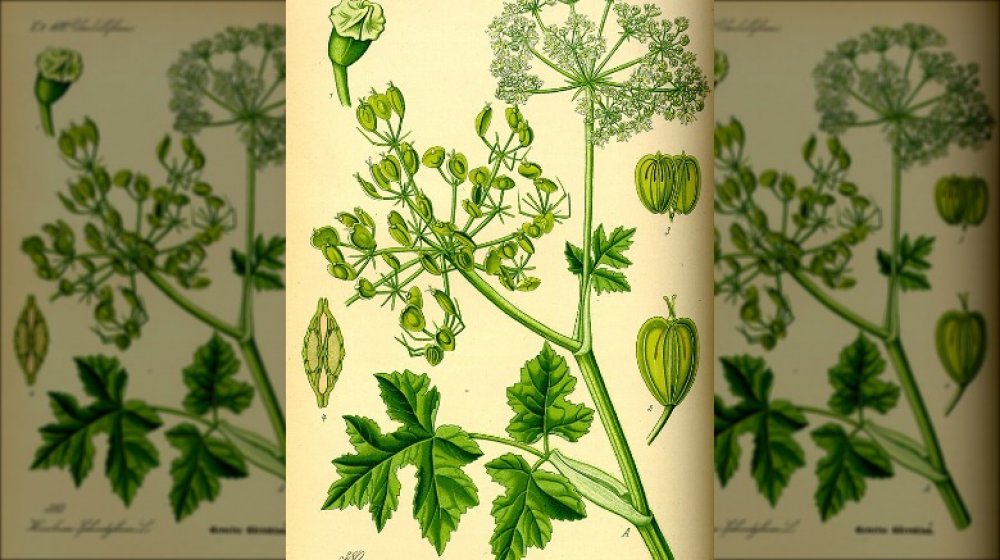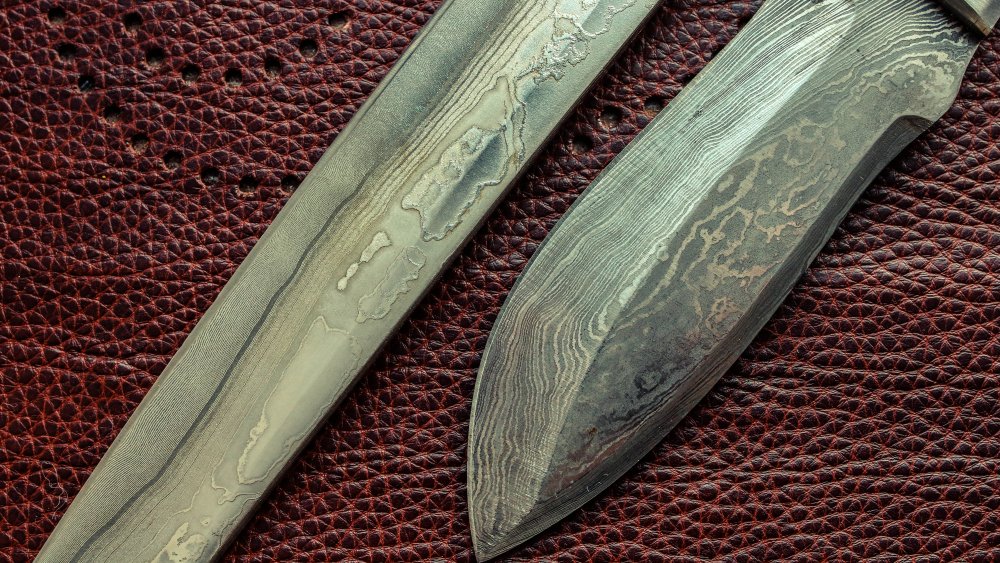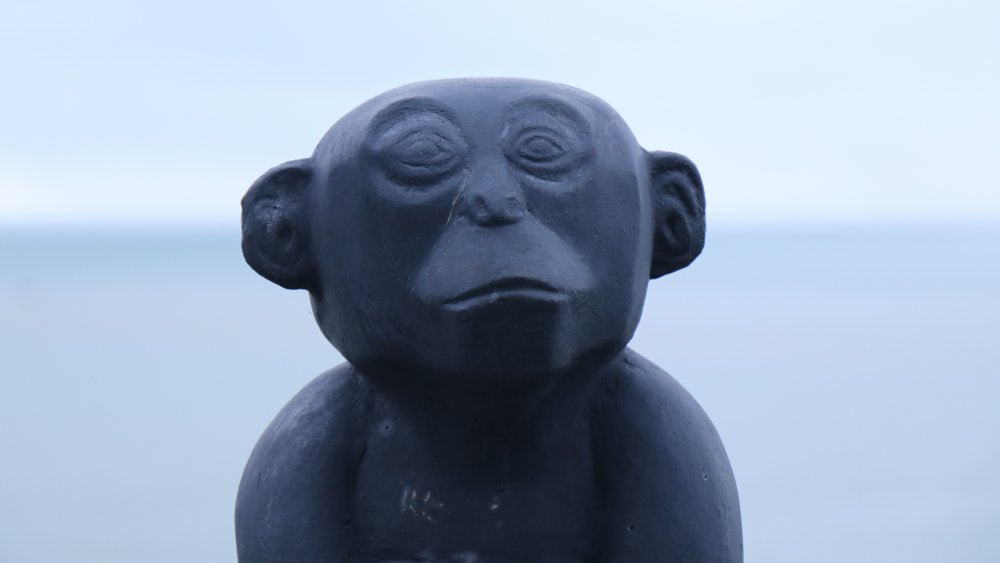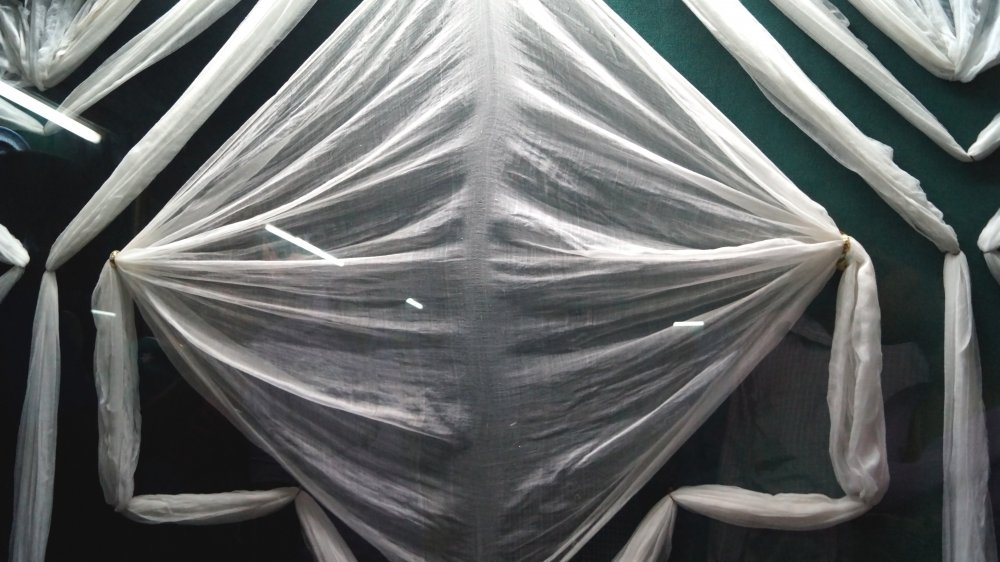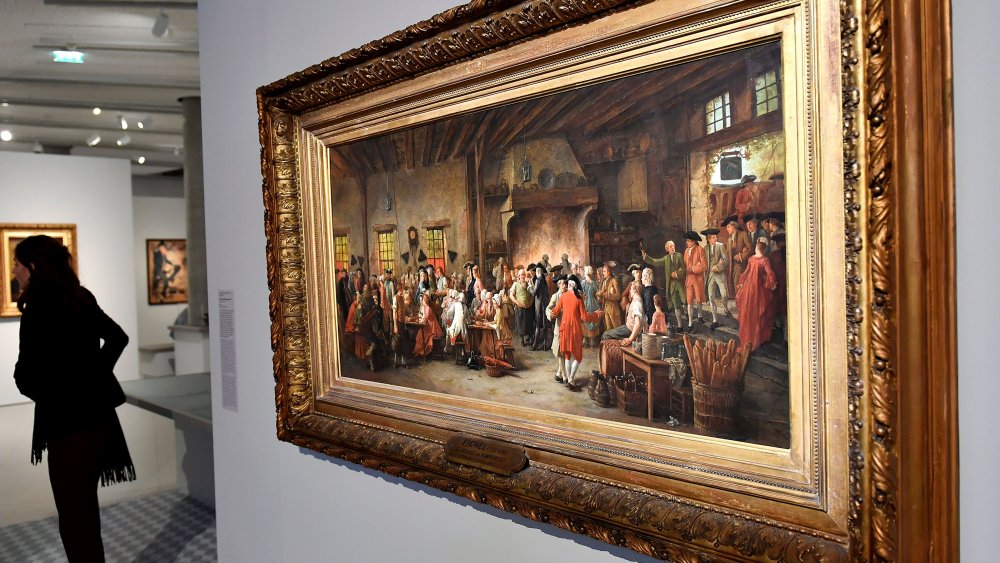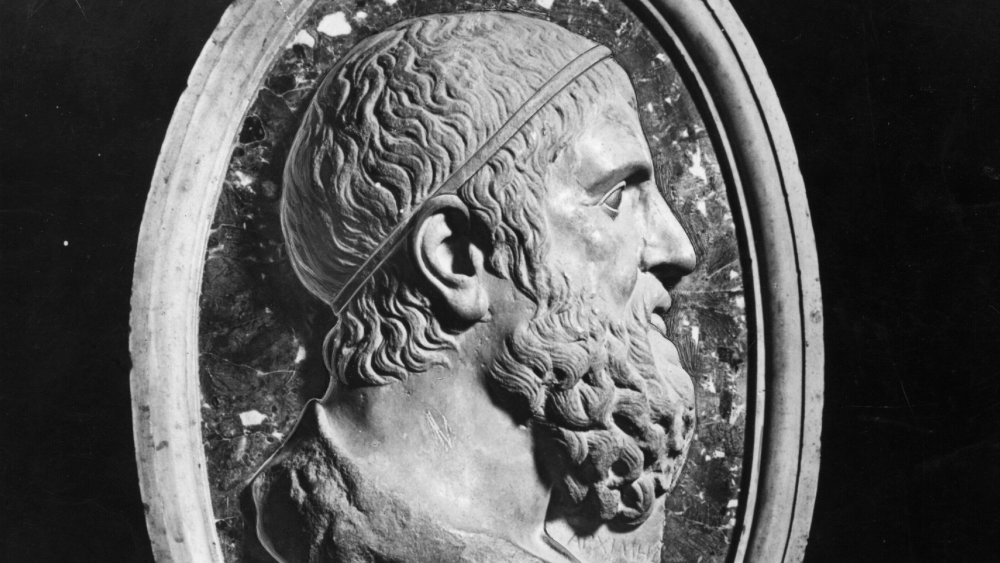The Biggest Inventions Lost To Time
It's no secret that 21st century humankind thinks it's pretty neat, with computers and Netflix and tacos. Sure, there's been great inventions leading up to the end of the millennium, but there have been some even more incredible ones that were lost long ago.
Take the Antikythera Mechanism. It's the one that almost everyone has heard of, a mysterious, 2,000-year-old device found on a shipwreck off the Greek island that it shares a name with. For more than a century, people have been trying to figure out what it is, and the general consensus is that it's some kind of ancient Greek computer. It's a gorgeous machine made with craftsmanship about 1,600 years ahead of its time, and over the decades, Vox says researchers have worked out that it is, indeed, an insanely complicated gadget that used the mathematical ratios of its many gears to calculate solar and lunar calendars, eclipses, the position of the moon, sun, and plants, and would even keep track of the phases of the moon. Pretty cool, right?
It's proof that mankind has lost some incredible technology along the last few millennia, so... what else have we lost?
Silphium: The mysterious Roman herb lost to history
Texts from ancient Rome and Greece tell of an herb of almost infinite use. It was silphium, and it was edible, it was a preservative, it was turned into a perfume and a condiment, it was an aphrodisiac, and it was used to treat a variety of medical conditions. The BBC says that it was very likely one of the first methods of birth control that actually worked.
Pliny the Elder wrote (via the Manchester Museum) that it only grew in Cyrenaica, and it was extinct by the 2nd century BC. The last stalk went to Emperor Nero; he wasn't the first Roman emperor to treasure it, as Julius Caesar reportedly kept 1,500 pounds of the plant's resin in the royal treasury, and Augustus requested it be given to Rome as tribute.
And here's the truly fascinating thing — historians know it existed, and know what it looked like. The region it came from was once the richest in the world, and their coins were engraved with the image of the plant. But no one is really sure what, exactly, it was. It was impossible to domesticate or raise anywhere outside of North Africa, and based on the ancient drawings and descriptions, it's believed to be closest to giant fennel, and best of all? We can't even know for sure that it's really extinct, because no one knows what they're actually looking for.
Damascus steel: The inspiration for Valyrian steel
It was during the Crusades that rumors of intricately patterned swords carried by Middle Eastern warriors started to spread throughout Europe. It was the 11th century, and they were seemingly impossible to break, nick, or wear. They were Damascus steel, and no one's sure just how they were made. And let's clear something up right away — the "Damascus steel" heavily featured on shows like Forged in Fire isn't the same thing. According to scientific development expert Jeffrey Wadsworth (via Time), those blades are more accurately called just layered metals. And he knows — he (and colleague Oleg D. Sherby) believe they've made strides toward finding the real thing.
While modern Damascus steel gets a pattern from folding metal, ancient Damascus steel gets ripples from the arrangement of the crystals in the metal, which was called wootz. What Wadsworth and Sherby accidentally discovered was when they tried to make steel that stretched at high temperatures by shrinking the size of the grains, they ended up with a high-carbon steel that wasn't brittle.
And that, they think, forms the basis of the ancient art. What they don't know is just how ancient smiths got the same effect in their blades. John Verhoeven from Iowa State University believes (via New Scientist) trace elements like vanadium helped create the right pattern, but it seems as though the ancients have taken their their rituals to the grave.
Immortality: The petrification of human bodies
There is no shortage of possibilities for the bodies of those who have died, and more and more are being developed all the time. There's one that's shrouded in mystery, no pun intended, and that's the process of petrification.
Girolamo Segato was a 19th century Italian cartographer and naturalist. By 1824, he had found his calling: experimenting with the use of metals and other substances to preserve organic materials. He was wildly successful, too, petrifying pieces of the human body as well as entire animals, and creating eerie sculptures and exhibits from them. Valentine Mott, known as the Father of American Vascular Surgery, once wrote of him: "This extraordinary man must have inherited the magic shield of Perseus, that, with the snaky tresses of the Gorgon Medusa's head, enabled him to convert everything he touched to stone."
But researchers from the UNIFI say that his methods died with him. Preservation of human organs as indestructible stone artifacts would have made valuable teaching tools, and it would have allowed for the study of even the rarest of diseases and conditions. But he not only refused to share his methods, but he also destroyed all of his notes. Why? Two very influential organizations — the Church and polite society — frowned upon his work.
Stradivarius violins: Unequaled sound
In 2011, the BBC reported that a single violin had just sold at auction for somewhere around $12.8 million. That's an insane amount of money, even if the violin was one of the most well-known types of instruments in the world: a Stradivarius. Antonio Stradivari was born around 1644, died in 1737, and made about 1,000 violins, violoncellos, and violas. Those that survive are still lauded for their incredible sound, and no one knows why these particular stringed instruments are so amazing.
There's been a number of theories put forward, and some of them have to do with the wood used. In 2003, a group of US researchers postulated that unique solar activity in the 17th century had created denser trees that were then harvested to make denser-than-normal wood with unusual acoustics. Then, in 2016, researchers suggested (via The New York Times) that shavings taken from some of his violins yielded unusual results: they had been treated with things like calcium and aluminium.
But Ashmolean Museum curator Dr. Jon Whiteley says it's all about technique. Stradivarius was working at a time when performances were moving from small salons to massive concert halls, and he needed to find a way to change the way an instrument projected sound — long before electric amps. He experimented with different shapes, and found ones that work the best. But... it can't be that easy.
The Telharmonium: A pre-internet Spotify
In 1893, an amateur inventor named Thaddeus Cahill had a crazy idea: wouldn't it be cool if live music could be delivered into homes and businesses via the telephone lines? And yes — we are definitely talking about the year 1893. It must have sounded so wonderfully insane at the time, and according to Inverse, he made it happen.
The Telharmonium, says the History of Recording, was a ridiculously complicated device made up of rotating electromagnetic generators and a system of alternators, cogs, wire brushes, and shafts that all created a frequency that could be heard by a telephone receiver. The phone lines needed to be able to do more than just hear it, they had to be able to amplify it — a whole other problem. Still, he had a working model by 1901, and a synthesizer that could mimic all kinds of different instruments based on what lever was pulled. The machine was about 60 feet long, weighed more than 200 tons, had more than 2,000 switches, and cost about $4 million to build. (That's just the console pictured.)
Unfortunately, technology wasn't ready for Cahill's invention. The phone lines weren't capable of handling streaming music and talking people at the same time, and this was the same time Marconi and Tesla were working on wireless communication. Add in the size and the expense, and it wasn't a hit. Sadly, the Telharmonium itself was dismantled, and no recordings were actually made.
Dhaka muslin: A fine cloth fit for royalty
Muslin is still made today, and it's a typically lightweight, inexpensive material made from cotton. That's not what ancient Dhaka muslin was — this was material fit for royalty, given names like Ab-e-rawan (running water) and Shabnam (evening dew), and made exclusively by weavers in Bengal. According to AramcoWorld, it was one of the finest exports traded with the Roman Empire, and it was in such high demand it was immortalized in song and poem as a fabric so delicate that a whole garment could be kept in a tiny box.
According to most stories, once the British Empire came stomping along with their colonial boot, the production of Dhaka muslin was just one of the things they stomped on. They wanted to corner the market, and legend says that the weavers of Dhaka muslin had their thumbs cut off so they could no longer weave.
It's doubtful that's the whole truth, but we do know it's impossible to make it today. It was spun from a particular type of cotton that grew only in a section of land along the Meghna, and only about 8 percent of the harvested cotton was fine enough to be made into muslin, and only the weavers with the lightest, most delicate touch could do it. Even if those weavers were still around, they'd still have a problem: the only cotton suitable for Dhaka muslin, the phuti karpas, has gone extinct.
Roman concrete: Still standing
Ever wonder why ancient Roman aqueducts are still standing, while there's huge pieces falling off the 20-year-old bridge by your house? Scientists are wondering that, too.
Especially when you consider that there's a ton of ancient Roman structures that aren't just standing, but that have withstood centuries of being battered by storms and, in some cases, ocean waves. According to Science Alert, researchers have only been able to explain a bit about what's going on here, and geologists from the University of Utah have confirmed that ancient concrete isn't just holding strong, it's getting stronger.
It's thought that the ancient Romans noticed how volcanic ash went through a sort of natural process and formed a hard cement, and gradually, they added more substances to their volcanic ash base. The ash — along with the other ingredients — actually reacted with salt water to form a structure that was continuously strengthened, instead of being worn away. With the help of electron microscopes, they're hoping to discover what minerals make up this ancient concrete and reverse-engineer it back to the actual recipe that has been lost for centuries. Even if they do figure it out, though, there still could be a problem: it seems a very particular type of rock base was used to start with, and not all rocks are created equal.
Mummy brown: The paint color that's not just a name
Take a look at any one of a number of paintings from the 16th century to the early 20th, and take special note of the browns. There's a good chance one brown in particular is called mummy brown, and that's because it was made Soylent Green-style.
Mummy brown was, indeed, made from mummies. National Geographic says they were shipped to Europe by the boatload, where they were ground up for use in everything from medicines to fuel. Somewhere in between those two extremes falls "art supplies," and they were definitely used for that, too. The pigment's heyday was just after the Napoleonic invasion of Egypt in the 18th century (mummies were mainly but not exclusively medicinal before that), and according to the Journal of Art in Society, the pigment was prized as a paint that was easy to work with, had good transparency, and was extremely versatile as both an oil and a watercolor paint.
Yikes. It's also worth noting that many artists had no idea their mummy brown paint was actually made from mummies — most assumed it was just a weirdly descriptive name. Some insisted on giving their paints a proper burial once they found out the truth, and while it's obvious we've lost the ability (and desire) to make paint out of people, mummy brown remains lost for another reason: it's impossible to tell which paintings were actually made with authentic mummy brown.
Starlite: The super-indestructible mystery material
Everything about Starlite sounds improbable, and it starts in 1986. That's when hairdresser and amateur chemist Maurice Ward was experimenting with plastic coatings, and stumbled across something that had stumped scientists and military inventors for a long, long time. The material he called Starlite was so resistant to heat it could withstand the strength of 75 nuclear blasts, and it's easy to see why this one would be super useful for a lot of people.
Ward debuted his material on an episode of Tomorrow's World. He took an egg, coated it in Starlite, and put it in front of the heat. When they cracked it open, the egg was still perfectly perfect. He claimed that he had been inspired by the story of the British Airtours Flight 28M, and after hearing about passengers trapped in a burning plane, he started experimenting to see if he could come up with a solution. He did — he accidentally stumbled on something that wouldn't burn, tweaked it a bit, and had something that was heat-resistant up to around 18,000 degrees Fahrenheit.
Starlite's properties were verified by organizations like NASA and the British Atomic Weapons Establishment, but no one would ever benefit from it. According to Big Think, Ward was extremely secretive, difficult to work with, and died in 2011 — taking his secret recipe with him.
Greek fire: The ancient world's napalm
In the 670s, Arab ships attacking the Byzantine fleet were greeted with a strange sight: ships outfitted with siphons. Those siphons spit Greek fire, named for Callinicus of Heliopolis, a Jewish refugee and reputed inventor of the mysterious weapon (via History Extra).
And it was terrifying. Not only would water not extinguish it, but it would stick to flesh and keep flaming. According to New Scientist, researchers think they know what some of the key ingredients were: a highly flammable crude oil and pine resin, which would account for Greek fire's sticky reputation and tendency to burn for a long time. But that's only part of the mystery, and exactly how ships spread the Greek fire was equally mysterious. Even enemies who captured equipment reportedly couldn't make heads or tails of it, and it seems as though they had actually used a complex pump system made of bronze that pressurized the heated oil.
The Byzantine weapon — which isn't the same Greek fire that was used during the Crusades, that was a mix of turpentine and saltpeter — was understandably a well-protected secret. Interesting Engineering says it was passed down from emperor to emperor, and well, they were so successful that it's still a secret.
Archimedes' death ray: Yippie-ki-yay, eureka!
The most famous story about Archimedes is the one where he sat in the bath, noticed the displacement of water, then went streaking through town to celebrate. That's not all he was known for, though, and in 212 BC, he was credited with building a death ray.
It was during the Siege of Syracuse, and the story goes that he threw together a bit of glass and mirrors that focused light and became a sort of death ray, setting nearby enemy ships aflame. There have been a number of attempts to try to recreate his death ray using various mirrors, and while some claim that it's just not possible, others — like the students at the Massachusetts Institute of Technology — carried out experiments with mirrors and faux enemy ships only to declare that yes, it actually was possible he'd done such a thing.
Researchers from the University of Naples have a bit of a different idea (via The Christian Science Monitor). They looked at Leonardo da Vinci's 15th century sketches of steam cannons — weapons he credits Archimedes with discovering — and it led them to the suggestion that he had, in fact, created a death ray of a different kind. A heated cannon like the one in the design would need just a tenth of a cup of water to create enough steam to launch hollow clay balls filled with a highly flammable liquid. Eureka, indeed.
Mithridatum: The antidote to everything
Being a king in ancient times was a tough job. Everyone was out to kill you, and when your rule is punctuated by ruthless expansion and bitter conflicts, the chances of being served a healthy helping of poison alongside dinner was real. That was the fear of King Mithridates VI, who was particularly hated by the Romans. (It might have something to do with that time he killed 150,000 of them in a single day.)
Mithridates was incredibly paranoid — rightfully so, says Ancient History, and he was particularly afraid of poison. So, he decided to create an antidote against any type. He tested his antidotes on prisoners, and according to Pliny the Elder, he found his magic antidote. Pliny claimed it had more than 50 ingredients, and Mithridates believed it was real — he would regularly eat poison, just to prove it was. What's going on?
It's possible there's a few things: it's been suggested that his antidote — mithridate, or mithridatium — was a combination of actual antidotes and real poisons. By regularly taking the antidote to some substances, he would have been protecting himself that way. But by regularly ingesting small amounts of various poisons, he could have been building up an immunity. Could he have done it? No one's sure, but when he tried to kill himself by splitting a dose of poison with his daughter, he survived — it took a blade to finish him off.

